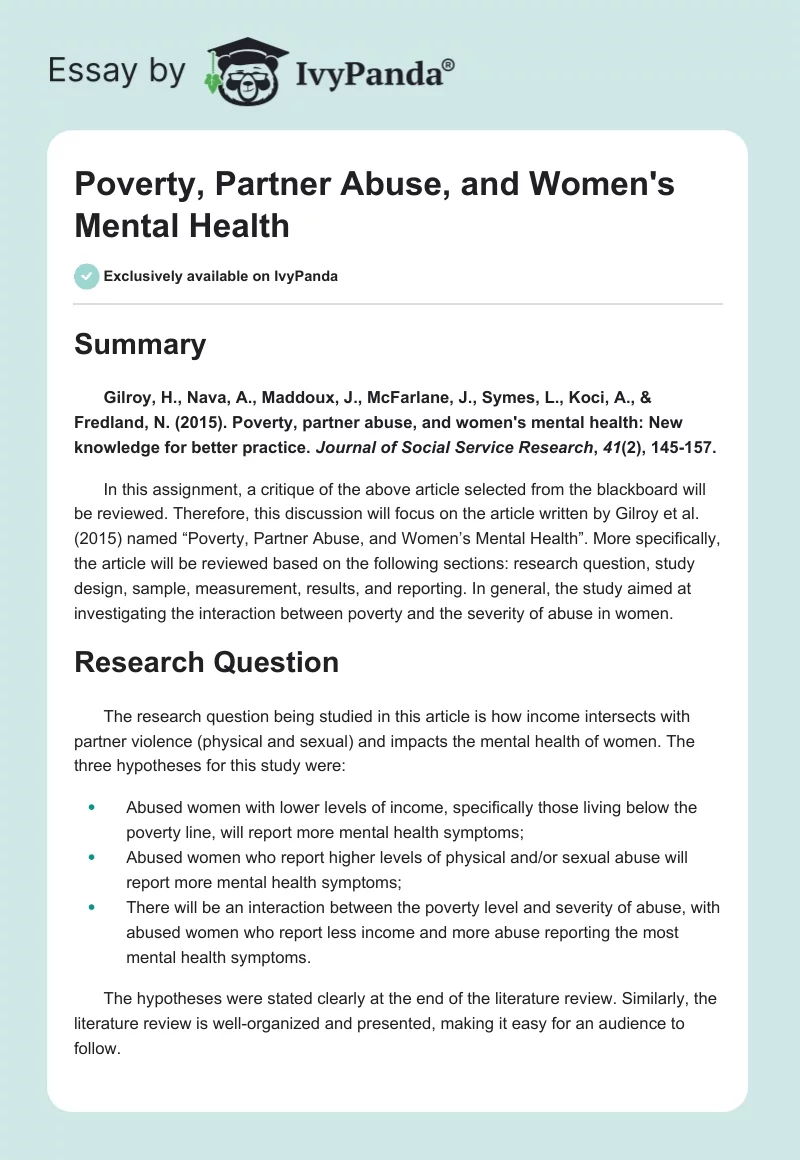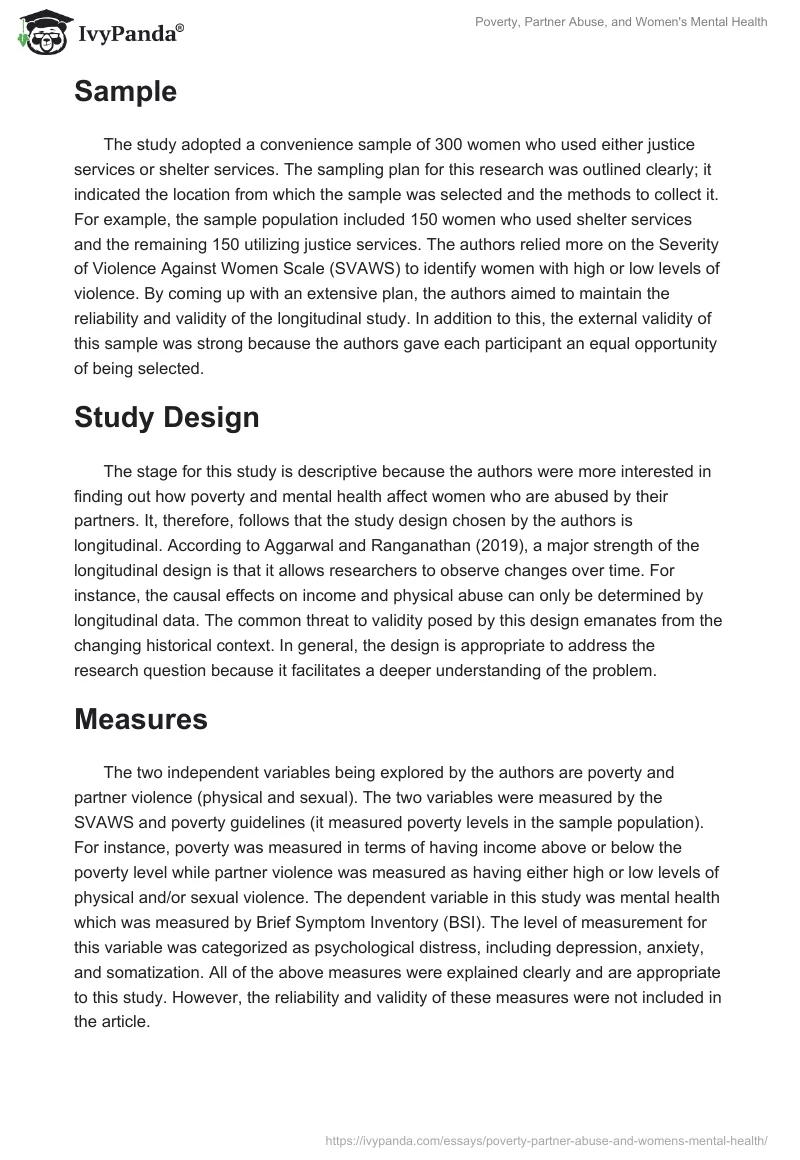Summary
Gilroy, H., Nava, A., Maddoux, J., McFarlane, J., Symes, L., Koci, A., & Fredland, N. (2015). Poverty, partner abuse, and women’s mental health: New knowledge for better practice. Journal of Social Service Research, 41(2), 145-157.
In this assignment, a critique of the above article selected from the blackboard will be reviewed. Therefore, this discussion will focus on the article written by Gilroy et al. (2015) named “Poverty, Partner Abuse, and Women’s Mental Health”. More specifically, the article will be reviewed based on the following sections: research question, study design, sample, measurement, results, and reporting. In general, the study aimed at investigating the interaction between poverty and the severity of abuse in women.
Research Question
The research question being studied in this article is how income intersects with partner violence (physical and sexual) and impacts the mental health of women. The three hypotheses for this study were:
- Abused women with lower levels of income, specifically those living below the poverty line, will report more mental health symptoms;
- Abused women who report higher levels of physical and/or sexual abuse will report more mental health symptoms;
- There will be an interaction between the poverty level and severity of abuse, with abused women who report less income and more abuse reporting the most mental health symptoms.
The hypotheses were stated clearly at the end of the literature review. Similarly, the literature review is well-organized and presented, making it easy for an audience to follow.
Sample
The study adopted a convenience sample of 300 women who used either justice services or shelter services. The sampling plan for this research was outlined clearly; it indicated the location from which the sample was selected and the methods to collect it. For example, the sample population included 150 women who used shelter services and the remaining 150 utilizing justice services. The authors relied more on the Severity of Violence Against Women Scale (SVAWS) to identify women with high or low levels of violence. By coming up with an extensive plan, the authors aimed to maintain the reliability and validity of the longitudinal study. In addition to this, the external validity of this sample was strong because the authors gave each participant an equal opportunity of being selected.
Study Design
The stage for this study is descriptive because the authors were more interested in finding out how poverty and mental health affect women who are abused by their partners. It, therefore, follows that the study design chosen by the authors is longitudinal. According to Aggarwal and Ranganathan (2019), a major strength of the longitudinal design is that it allows researchers to observe changes over time. For instance, the causal effects on income and physical abuse can only be determined by longitudinal data. The common threat to validity posed by this design emanates from the changing historical context. In general, the design is appropriate to address the research question because it facilitates a deeper understanding of the problem.
Measures
The two independent variables being explored by the authors are poverty and partner violence (physical and sexual). The two variables were measured by the SVAWS and poverty guidelines (it measured poverty levels in the sample population). For instance, poverty was measured in terms of having income above or below the poverty level while partner violence was measured as having either high or low levels of physical and/or sexual violence. The dependent variable in this study was mental health which was measured by Brief Symptom Inventory (BSI). The level of measurement for this variable was categorized as psychological distress, including depression, anxiety, and somatization. All of the above measures were explained clearly and are appropriate to this study. However, the reliability and validity of these measures were not included in the article.
Data Collection
The data for this study was collected from entry interviews with a sample size of 300 women. The women who utilized shelter services were interviewed within the first 48 hours of their arrival, while those using justice services were interviewed as they waited to see a caseworker. Some of the strengths of the data collection plan include: allowing the researcher to pose new questions and the information acquired is likely to be more accurate than other methods (Glegg, 2019). The main limitation of this method is that it can cause gender bias by using only women for generalizability.
Findings
The findings of this study showed no direct effect of income on poor mental health. However, the interaction between type and severity of abuse and income level had a significant impact on mental health. The findings further indicated that the abused women with high income reported high levels of depression with high physical and sexual abuse. The results were correctly drawn from the sample and analyzed through analysis of variance (ANOVA) tests (Delacre et al., 2019). Overall, though the findings partially supported the study hypothesis, there was a clear indication that they were reliable and valid.
Reporting
The article was well-organized; it followed the basic structure of a research paper with an introduction, methods, results, and discussion. The article is also written clearly with the authors focusing more on getting straight to the point. The target audience for this study includes the policymakers, the ministry of health (healthcare workers), and the general public (adults and teenagers). For instance, adults are targeted because they can make a change by helping those living in poverty. Unfortunately, the implications for policy and practice were not sufficiently discussed; the study concluded by emphasizing the need for more research on effective programs to maximize mental health functioning.
References
Aggarwal, R., & Ranganathan, P. (2019). Study designs: Part 2–descriptive studies.Perspectives in Clinical Research, 10(1), 34. Web.
Delacre, M., Leys, C., Mora, Y. L., & Lakens, D. (2019). Taking parametric assumptions seriously: Arguments for the use of Welch’s F-test instead of the classical F-test in one-way ANOVA.International Review of Social Psychology, 32(1), 1-12. Web.
Gilroy, H., Nava, A., Maddoux, J., McFarlane, J., Symes, L., Koci, A., & Fredland, N. (2015). Poverty, partner abuse, and women’s mental health: New knowledge for better practice. Journal of Social Service Research, 41(2), 145-157. Web.
Glegg, S. M. (2019). Facilitating interviews in qualitative research with visual tools: A typology. Qualitative Health Research, 29(2), 301-310. Web.


